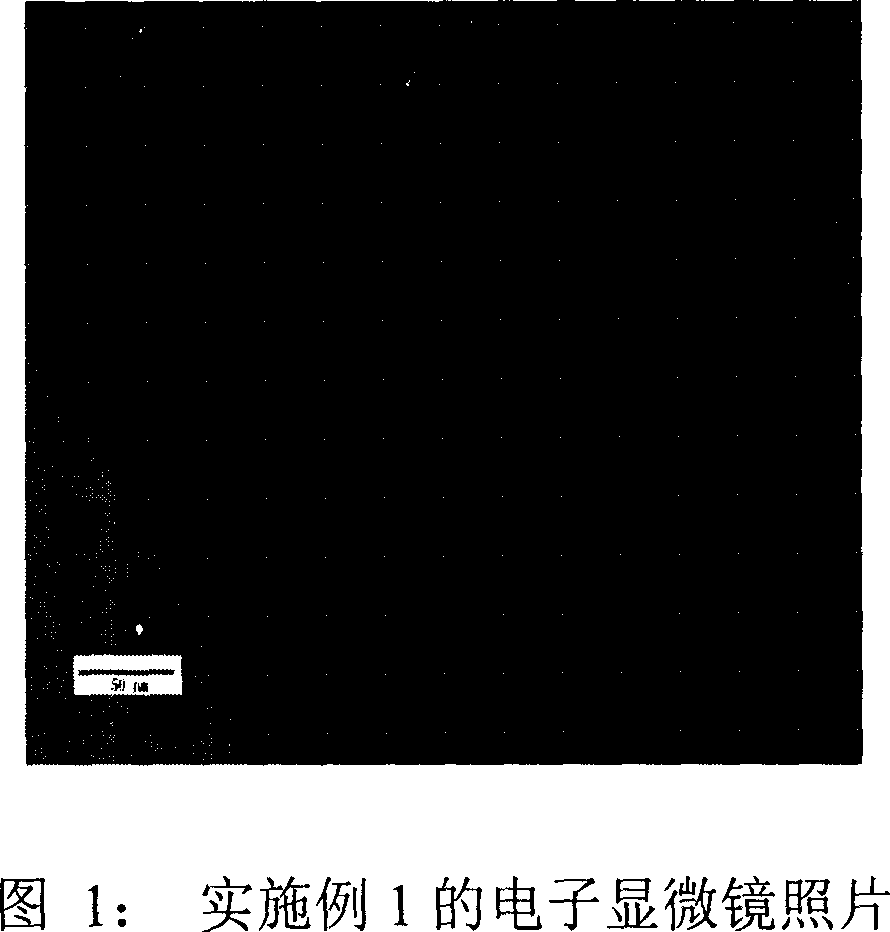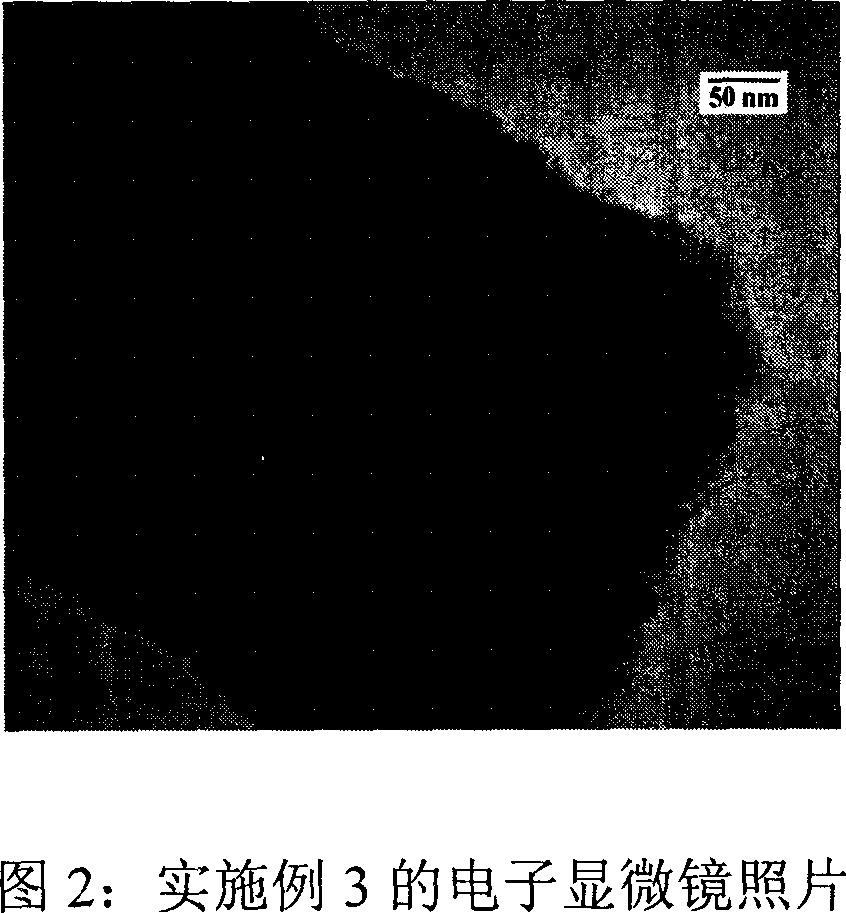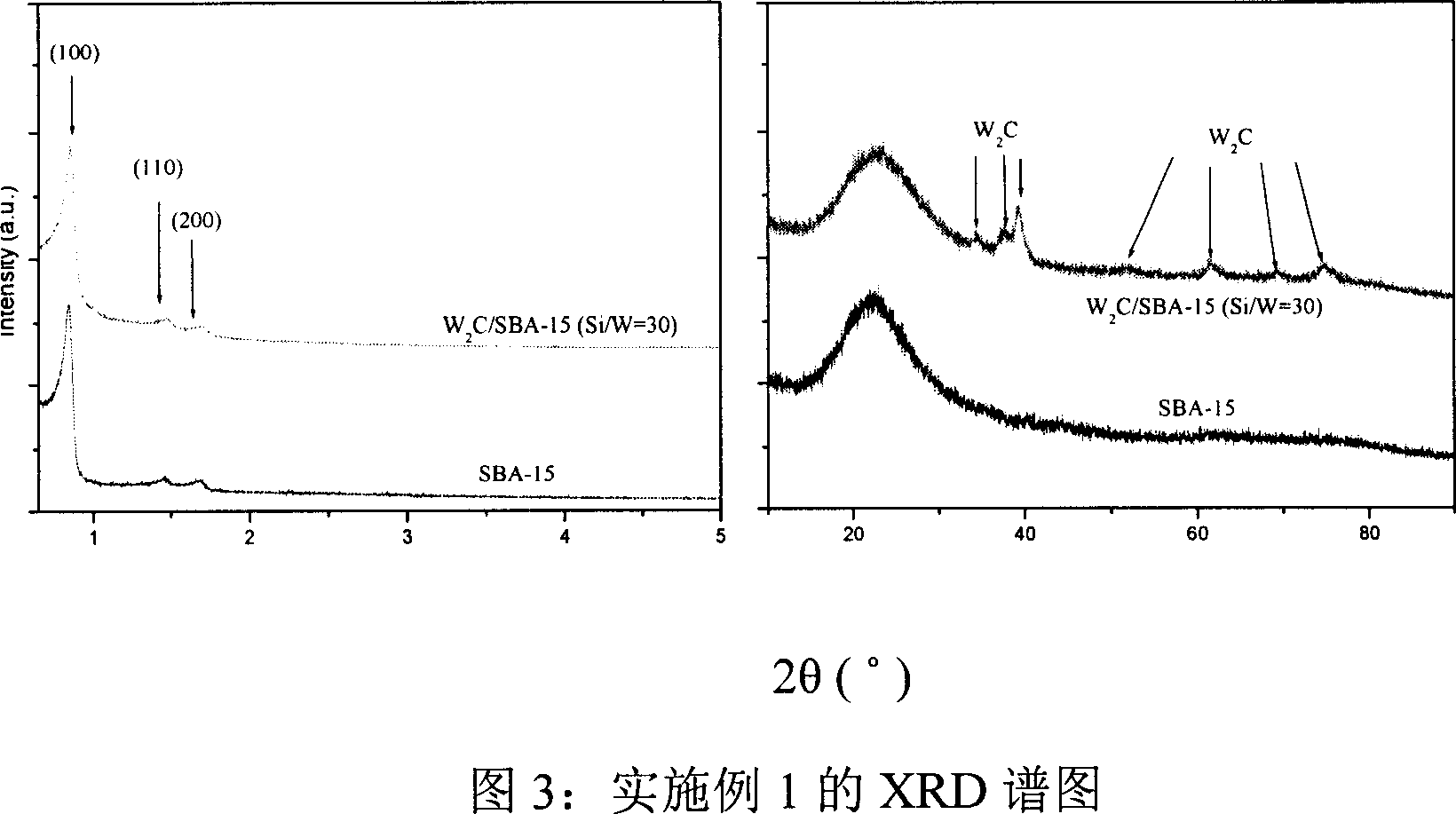Porous molecular-sieve catalyst for assembling carbide and its preparation
A mesoporous molecular sieve and catalyst technology, applied in the field of catalysis, can solve problems such as easy aggregation of carbide active component particles, inconvenient use, and decreased catalytic activity, achieving low cost, simple method, and good low-temperature catalytic activity Effect
- Summary
- Abstract
- Description
- Claims
- Application Information
AI Technical Summary
Problems solved by technology
Method used
Image
Examples
Embodiment 1
[0027] (1) Add 0.43g EO 20 PO 70 EO 20 (Molecular weight is 5800) Dissolve the template agent in 167ml deionized water, add 41.67g hydrochloric acid (4M) in a water bath at 50°C under stirring conditions, continue stirring for 3 hours, then add 41.67g tetraethyl orthosilicate (containing 0.2 moles of Si) , continue to stir for 24 hours, then transfer to a Teflon-lined autoclave, crystallize at 100°C for 24 hours, filter, wash, and suction filter, dry the obtained solid naturally at room temperature, and put it into a heating furnace In the process, the temperature was raised to 600°C at a heating rate of 2°C / min, and the temperature was kept constant for 6 hours to obtain the prepared SBA-15 mesoporous molecular sieve. Weigh ammonium paratungstate (5(NH 4 ) 2 O·12WO 3 ·5H 2 O) 1.30g (containing 0.005 moles of tungsten) was dissolved in 30ml of deionized water, then, this solution was impregnated in 9.01g (containing 0.15 moles of Si) SBA-15 mesoporous molecular sieve for...
Embodiment 2
[0031] (1) 1.35gEO 20 PO 70 EO 20 (Molecular weight is 5800) template agent is dissolved in 312ml deionized water, add 125.0g hydrochloric acid (4M) under 40 ℃ water bath, stirring condition, continue stirring for 5 hours, then add 20.83g orthosilicate ethyl ester (containing 0.1 mole of Si) , continue to stir for 30 hours, then transfer to a Teflon-lined autoclave, crystallize at 85°C for 32 hours, filter, wash, and suction filter, dry the solid naturally at room temperature, and put it in a heating furnace. Raise the temperature to 500°C at a heating rate of 2°C / min and keep the temperature constant for 7 hours to obtain the prepared SBA-15 mesoporous molecular sieve. Weigh ammonium paratungstate (5(NH 4 ) 2 O·12WO 3 ·5H 2 O) 2.61g (containing 0.01 mole of tungsten) was dissolved in 15ml of deionized water, then, this solution was immersed in 3.00g (containing 0.05 mole of Si) in SBA-15 mesoporous molecular sieve for 24 hours, after natural drying, and then put into th...
Embodiment 3
[0035] (1) Add 0.43g EO 20 PO 70 EO 20 (Molecular weight is 5800) Dissolve the template agent in 167ml deionized water, add 41.67g hydrochloric acid (4M) in a water bath at 50°C under stirring conditions, continue stirring for 3 hours, then add 41.67g tetraethyl orthosilicate (containing 0.2 moles of Si) , continue to stir for 24 hours, then transfer to a Teflon-lined autoclave, crystallize at 100°C for 24 hours, filter, wash, and suction filter, dry the obtained solid at room temperature and put it in a heating furnace , the temperature was raised to 600°C at a heating rate of 2°C / min, and the temperature was kept constant for 6 hours to obtain the prepared SBA-15 mesoporous molecular sieve. Weigh ammonium molybdate ((NH 4 ) 6 ·Mo 7 o 24 4H 2 O) 0.88g (containing 0.005 moles of molybdenum) was dissolved in 30ml of deionized water, then, this solution was impregnated in 9.01g (containing 0.15 moles of Si) SBA-15 mesoporous molecular sieve for 36 hours, after natural dry...
PUM
 Login to View More
Login to View More Abstract
Description
Claims
Application Information
 Login to View More
Login to View More - R&D
- Intellectual Property
- Life Sciences
- Materials
- Tech Scout
- Unparalleled Data Quality
- Higher Quality Content
- 60% Fewer Hallucinations
Browse by: Latest US Patents, China's latest patents, Technical Efficacy Thesaurus, Application Domain, Technology Topic, Popular Technical Reports.
© 2025 PatSnap. All rights reserved.Legal|Privacy policy|Modern Slavery Act Transparency Statement|Sitemap|About US| Contact US: help@patsnap.com



